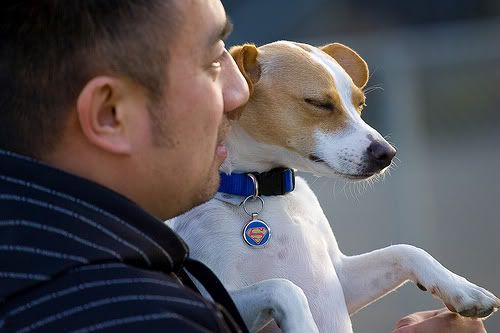Above: My students are always excited and happy to go to animal school!
Want to bump your training up to the 3rd power? If so, use the power of three–and if you have no idea about what I am talking about–keep reading.
There is a lot of hooey out there when it comes to animal training and methodology related to it. Popular opinion isn’t always right nor is it best for your animal.
Even so, people tend to ask around their social circles for information rather than seeking out good sources.
And sometimes those “good” sources aren’t really quality sources because if training isn’t someone’s area of expertise, in many cases the advice they give you is outdated, flat out wrong, or worse–inhumane.
Why would you use archaic info? Why would you be inhumane? Most people would be mortified to discover that they made a mistake so I am going to help you correct it–or avoid making a huge mistake.
People tend make animal training mistakes they don’t know the advice they get is outdated or because they trust the source instead of doing some digging, sound familiar?
Anyway, I wanted to take about my 3Rs of training which make you more effective and make things more fun for the animal you are training are:
3Rs of Animal Training
- Request,
- Response,
- Reinforce
If you are into progressive animal training techniques these steps are essential. If you are a pet owner, they are critical to your success and for creating a happier animal.
One of the big rewards I get as an animal behavior training consultant is that my students anticipate animal school and actually are excited about it. This is because it is a positive experience for them. They love it (and me–which is super reinforcing for any trainer BTW).
Instead of repeating, repeating, and repeating, the best thing to do is follow the Ask, Tell, Take Action steps I discussed previously.
But, it is also important to understand the 3Rs because it is different from some of the older techniques people used for dog training.
In the past, pet owners were instructed to practice, practice, practice!
This meant repeating the training steps over and over again. Not only is this not fun, it is super boring and both the dog and owner lose interest. Many people find it to be too much work.
Request
If you request a behavior of an animal, you do it once. Because animal training is an art AND a science you would not always use the same strategy every time. Now this might be confusing but hang in there a minute…
Yes, you do need to be consistent but your next actions would depend on the animal’s response.
Response
Reacting and responding are two different things in my book. Reacting doesn’t involve a conscious choice so it isn’t something I desire from an animal. I want the animal to choose how to respond.
This calls to mine a low level incident that occurred with an attack trained dog that got a bit aggressive with me during exercise and play time. He was asked to respond but reacted with a different behavior instead.
In this case, I understood that he had been ingrained with a particular behavior to perform–he reacted but didn’t respond to my command. This is part of why some dogs keep on attacking when they are called off. (Reacting and adrenaline are not a good mix.)
In the end, his response (an immediate drop into a down position) was acceptable but it certainly wasn’t what I asked. My point here was that the reaction was okay and kept me safe and him out of trouble. BUT many animals react and fail to remain under the control of the handler in high stress incidents which can be a problem–and that is my point.
Also, animals taught to react do so in expectation of a negative consequence (or for you training tech term peeps, positive punishment) and to avoid it they fall back on what they find successful in most situations.
The animal has one of two responses available when requested–to respond as asked or to fail to respond as asked. This is where the reinforcement comes into play.
Reinforce
If an animal responds as requested, he or she will receive good stuff (technical–not!). If not, the window of opportunity closes and the animal loses any positive reinforcement. There isn’t a super negative consequence but he or she loses the opportunity for getting what is motivating him or her.
Depending on the animal, my next step might be to redirect into something else, ignore the animal, or end the session.
Cheyenne (in the video above) is a super thinker and over exuberant. This makes her a great student and a difficult one at the same time.
She will ad-lib because lay people (who are so excited that she performs for them) reinforce ANY response. But in my world, it has to be the requested response or it is a no go.
So, the next time you work training an animal, remember Request, Response, Reinforce. Practice it to see how it works for you.
As for Cheyenne, well, her main reinforcement is the reward of learning–but also my challenge that she focus. She works for me because she loves school–no necessarily treats. In fact, more often than not, she gets picky and spits them out. LOL
Care to share how your pet or animal responds during training? Do so over in the Facebook community or in the comments below (if they are still open).


